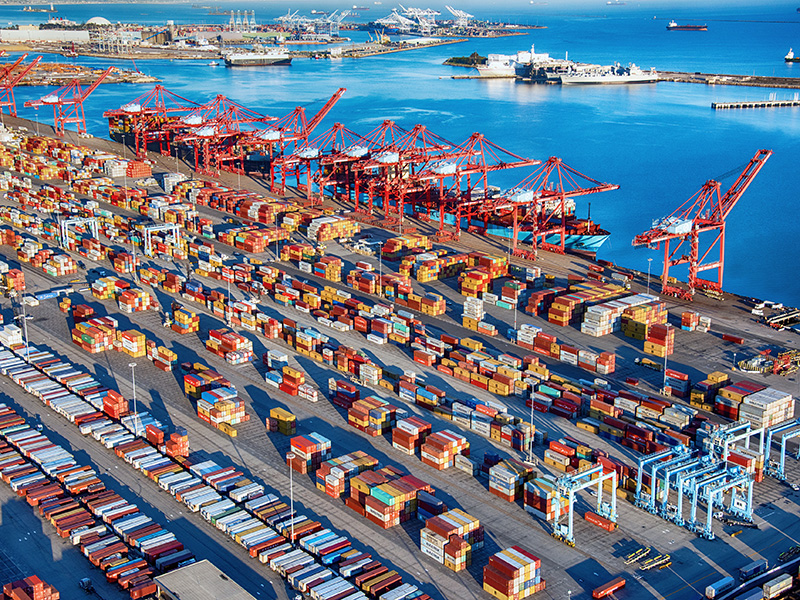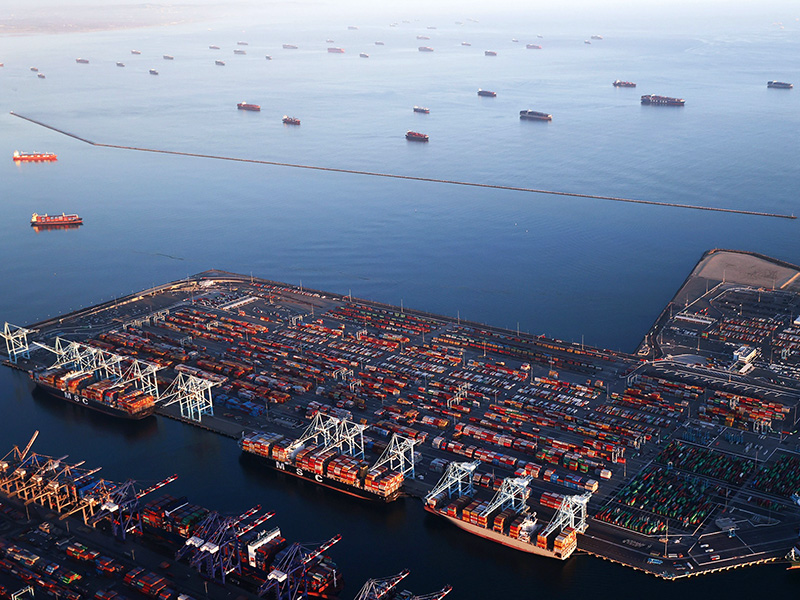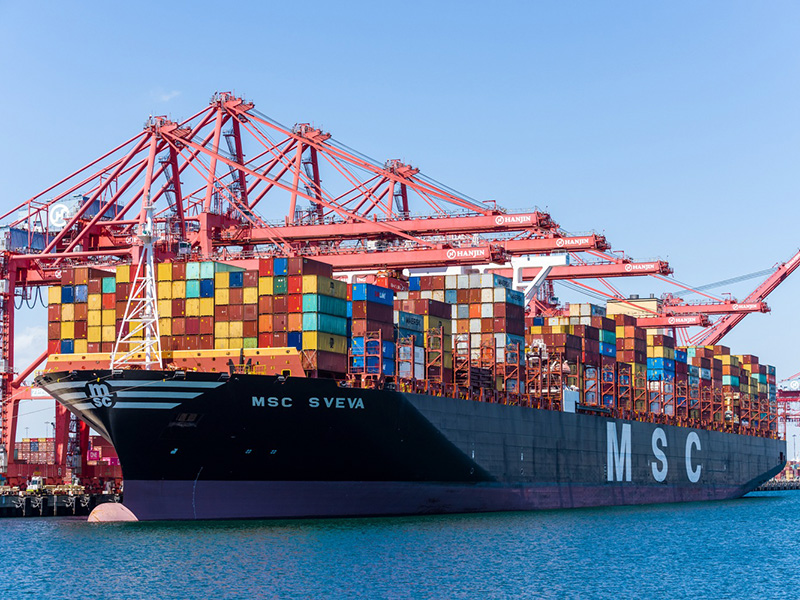Long Beach Port Vessel Schedule APIs
Vessel Schedule APIs for Long Beach Port Container Terminals
Long Beach Port is one of the largest and busiest ports in the United States, situated in Southern California. With a robust shipping infrastructure and strong global connections, integrating VesselMind APIs to access comprehensive vessel scheduling data for Long Beach Port's terminals is essential for streamlined operations and maintaining a competitive edge in the industry.

Terminals supported in VesselMind APIs
The following container terminals at the Port of Long Beach are supported by the VesselMind APIs:
- Pier A: Operated by SSA Terminals, Pier A is a major container terminal at the Port of Long Beach. It features state-of-the-art equipment, including 10 ship-to-shore cranes, extensive container storage capacity, and on-dock rail facilities with an intermodal rail car capacity of 63.
- Pier C: Managed by SSA Terminals Pier C, Pier C is a 70-acre terminal that features 3 quay cranes and handles general cargo in containers and automobiles. It also offers optional access to a 17.2-acre off-dock container yard.
- Pier E: Operated by Long Beach Container Terminal (LBCT), Pier E is a 170-acre container terminal equipped with 10 gantry cranes and on-dock rail facilities with an intermodal rail car capacity of 156. The terminal handles a variety of container vessels and is known for its high productivity rates.
- Pier G: The International Transportation Service (ITS) operates Pier G, a 246-acre terminal that includes 15 quay cranes and on-dock rail facilities with an intermodal rail car capacity of 80. The terminal is designed to handle large container vessels efficiently, ensuring smooth operations for shipping lines and logistics providers.
- Pier J: Managed by Pacific Container Terminal (PCT), Pier J is a 256-acre container terminal equipped with 17 quay cranes and on-dock rail facilities with an intermodal rail car capacity of 83. The terminal is capable of handling various vessel sizes and types and is committed to providing efficient and reliable container handling services.
- Pier T: Operated by Total Terminals International, Pier T is a 385-acre terminal that features 14 quay cranes, on-dock rail facilities with an intermodal rail car capacity of 174, and advanced tracking systems for efficient cargo handling. The terminal is designed to handle large container vessels, ensuring efficient and productive operations for shipping lines and other stakeholders.
Long Beach Port: A Technical Overview
Port of Long Beach is a major seaport located in Long Beach, California, serving as a strategic gateway for containerized cargo in the West Coast of the United States. The port facilitates a wide range of goods, including containers, breakbulk, and bulk cargo. Here's an in-depth look at the technical aspects of Long Beach Port and its terminals:
- UN/LOCODE: The United Nations Code for Trade and Transport Locations (UN/LOCODE) for the Port of Long Beach is USLGB.
- Coordinates: The geographic coordinates of the port are 33.7547° N, 118.2152° W.
- Channels: The port features a main channel with a depth of 76 feet (23 meters), allowing the passage of large container vessels.
- Annual Container Throughput: Long Beach Port is one of the busiest ports in the United States, handling millions of TEUs (Twenty-foot Equivalent Units) annually.
- Port Facilities: The port is equipped with various facilities, including container terminals, bulk and breakbulk terminals, and on-dock rail facilities, providing efficient and reliable services to the shipping industry.
- Environmental Initiatives: The Port of Long Beach is committed to minimizing its environmental impact through various initiatives, such as the Green Port Policy and the Clean Trucks Program, which aim to reduce emissions, conserve energy, and promote environmental stewardship.
How do I access the Vessel Schedule APIs for Long Beach Port?
To access the Vessel Schedule APIs for the Port of Long Beach's terminals, you can visit our developer page at /developers . Our APIs are designed to be user-friendly, allowing you to start receiving results in under 2 minutes!
The developer page includes comprehensive documentation and code samples for all major programming languages, making it easy to integrate the Vessel Schedule APIs into your existing systems. With VesselMind APIs, you'll gain access to accurate, up-to-date vessel schedules for Long Beach Port, ensuring seamless operations and efficient logistics management.
VesselMind APIs: Vessel Scheduling for Long Beach Port Terminals
VesselMind APIs provide a comprehensive solution for accessing vessel schedules at Long Beach Port's terminals, simplifying data management and ensuring smooth operations for all stakeholders. By integrating seamlessly with the port's existing systems, VesselMind APIs deliver a host of advantages for terminal operators, shipping lines, and other participants in the shipping process.
- Real-time vessel schedule updates : VesselMind APIs provide up-to-the-minute vessel schedule information, enabling terminal operators to efficiently manage berthing windows and resources. Shipping lines can also leverage real-time updates to optimize their route planning and enhance overall efficiency.
- Data consolidation and standardization : VesselMind APIs offer a single platform for accessing vessel schedules at Long Beach Port terminals, streamlining data management and ensuring stakeholders receive standardized and accurate information. This approach minimizes manual data entry and the risk of errors, resulting in more reliable and timely data.
- Improved collaboration and communication : VesselMind APIs foster better communication and collaboration among terminal operators, shipping lines, and other stakeholders, as they can access and share the same real-time data. This enhanced flow of information helps identify potential bottlenecks and enables faster decision-making.
- Customizable data access : VesselMind APIs offer flexible data access options, allowing users to tailor the information they receive based on their specific needs. Users can filter and search for data using various criteria, such as terminal, shipping line, or vessel type, ensuring they have the most relevant and useful information at their fingertips.
- Scalability and reliability : As the shipping industry continues to grow and evolve, VesselMind APIs provide a scalable and reliable solution for managing vessel schedules at Long Beach Port terminals. The robust infrastructure can handle large volumes of data and traffic, ensuring terminal operators and shipping lines can confidently rely on the system as their businesses expand.

Summary

VesselMind APIs offer a powerful and versatile solution for accessing vessel schedules at Long Beach Port terminals. By providing real-time updates, streamlining data management, and fostering better collaboration among stakeholders, VesselMind APIs contribute to more efficient and productive operations at Long Beach Port terminals. Embracing innovative solutions like VesselMind APIs can help Long Beach Port maintain its competitive edge and continue to serve as a vital hub for global trade and commerce.
